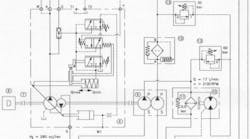There are a lot of motion-control applications hydraulics has a monopoly on. But what about those applications for which there is viable competition from mechanical or electro-mechanical alternatives?
When biases such as 'getting rid of the oil' (and the leaks that usually go with it) and eliminating the need for in-house hydraulics expertise (which can be hard to find and retain) influence end-users' buying decisions, a hydraulic solution becomes much harder to 'sell'.
Oil leaks and finding and retaining relevant expertise do impact life of machine ownership cost (LOMOC). And it's LOMOC which should be the definitive guide for the end user when choosing between competing motion control solutions.
The main components of LOMOC are:
- Initial capital outlay;
- Energy costs over the life of the machine; and
- Reliability - the cost of keeping the machine up and running and losses incurred when it isn't.
Mechanical and electro-mechanical solutions are often simpler and usually more energy efficient. And that's without considering maintenance and reliability. There's no oil leaks to worry about, no filters to change, no oil samples to take and no blown hoses to replace.
The reality is, compared with most mechanical or electro-mechanical devices, even a simple hydraulic system is a lot more complex maintenance-wise, and therefore more difficult to effectively maintain. Furthermore, the achievement of optimal maintenance and reliability outcomes is all too often compromised at the outset through bad or cheap design.
Oil quality, tank size, filtration, installed cooling capacity, conductor size and connector type are just a few of the corners that are all too easy to cut at the design stage. And while the end-user's initial capital outlay may be lower as a result, they will likely pay handsomely for this upfront discount over the life of the machine.
Even a relatively well designed (from a maintenance and reliability perspective) hydraulic machine will suffer from reliability issues if left to its own devices over time. This means optimal maintenance and reliability outcomes require a certain level of knowledge (and intervention) on the part of the end user. Unfortunately, this knowledge is often lacking-not only on the part of the end user, but the equipment manufacturer as well.
The result can be a hydraulic system that, perhaps quite rightly, is seen as unreliable, messy and expensive to operate. When an end user has this type of experience, it's not surprising that an aversion to hydraulics gets etched into their corporate memory.
In this context, every hydraulic system is an ambassador for the technology. If it turns out to be a lemon, it reflects badly on the entire industry. And lingering biases in the mind of the end-user can make a hydraulic solution a harder or even impossible sell in the future.
The imperative then, is to design and build hydraulic systems for maximum efficiency AND reliability. This means not only must designers know how to design systems for maximum efficiency; they must also know how to design them for maximum reliability. And it's the latter which presents the greater challenge-on two fronts.
Firstly, because the majority of hydraulic education available today focuses on how it works (or how it's supposed to work) rather than how and why it fails.
And secondly, designing for maximum reliability and minimum, initial capital outlay are incongruent. A change in industry culture from designing to price, to designing for optimum reliability and therefore minimum LOMOC, will be difficult, if not impossible, in a competitive marketplace driven by a race to the bottom mentality-unless the end user also becomes better educated and therefore more sophisticated in their equipment purchasing decisions.
In other words, the end user must be educated to think in terms of LOMOC for this shift towards the design and manufacture of better performing, and therefore more competitive, hydraulic machines to occur. And if you haven't read it yet, "Six Costly Mistakes Most Hydraulics Users Make, And How You Can Avoid Them!" is a very good place to start.

